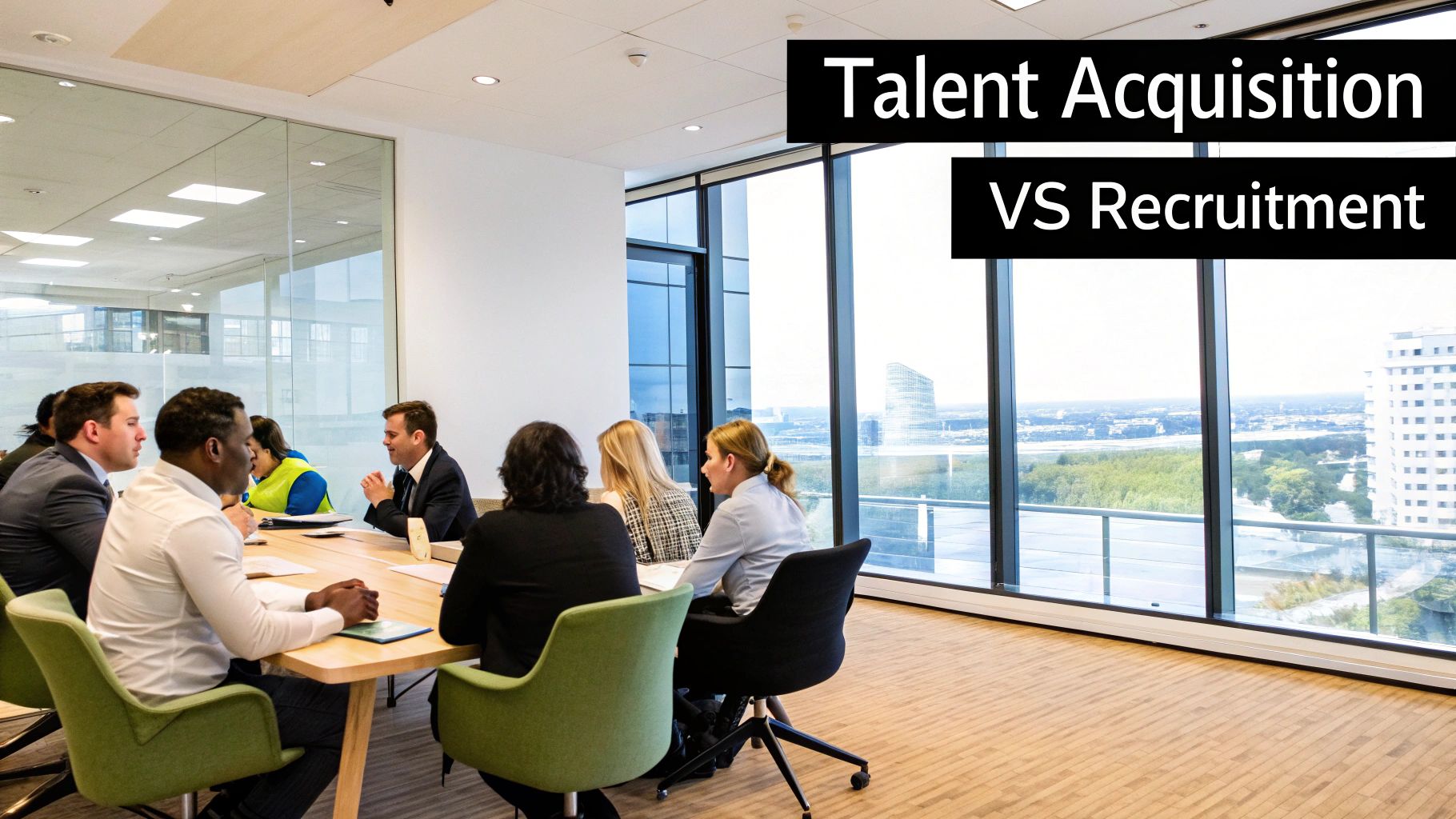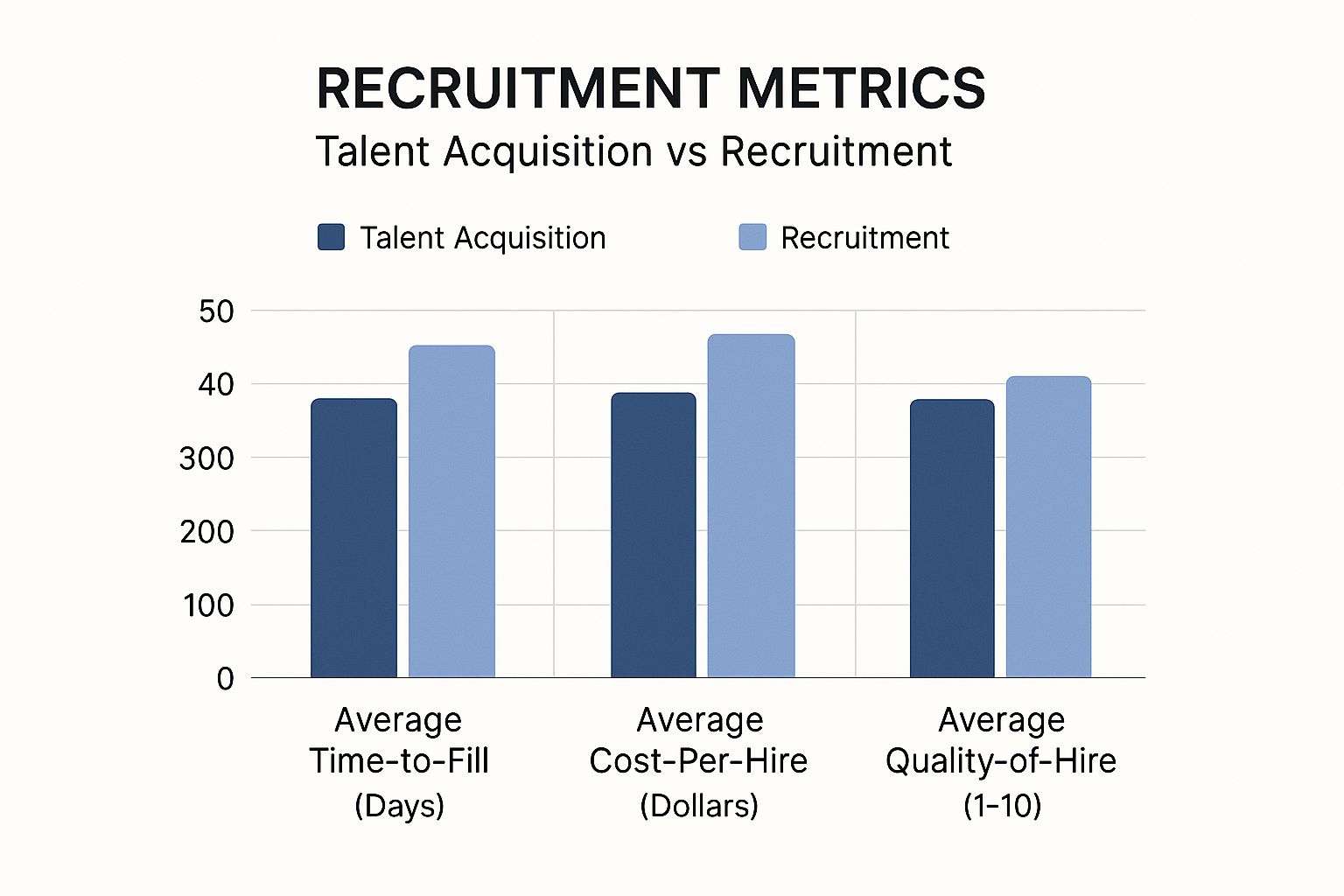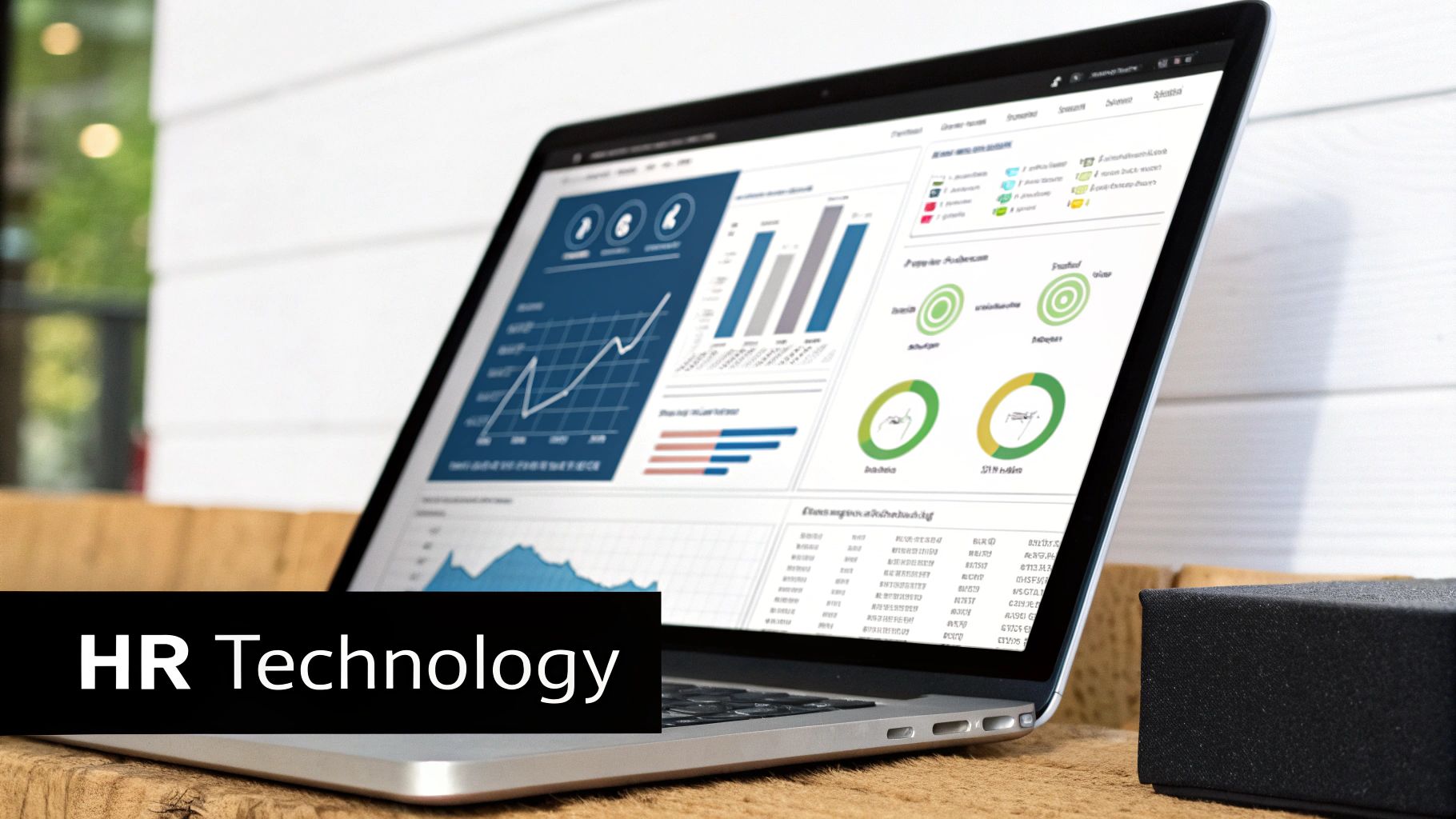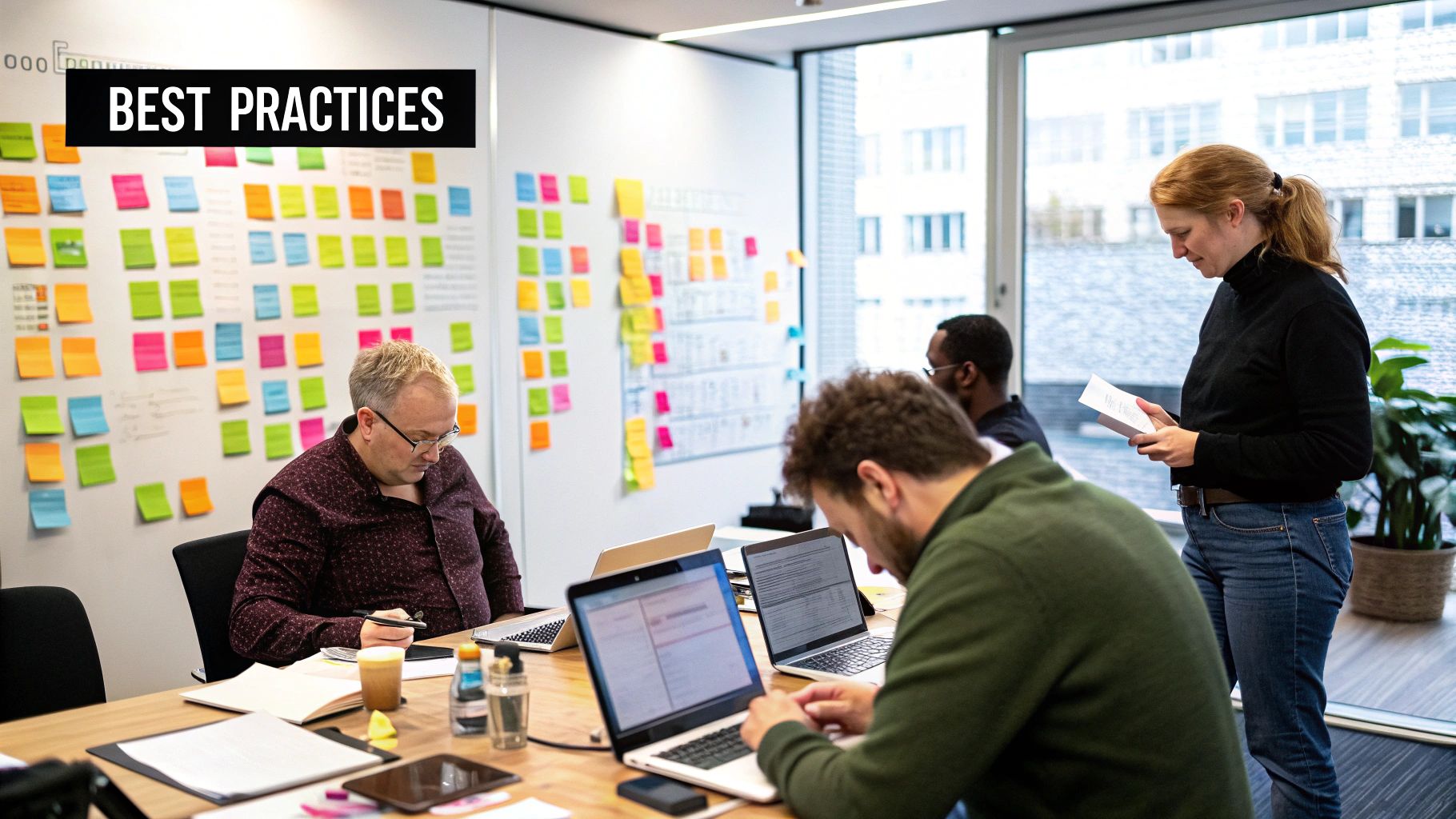While people often use the terms interchangeably, the real difference between talent acquisition vs recruitment is a matter of perspective. Think of it this way: recruitment is a short-term reaction to fill an empty seat, whereas talent acquisition is a long-term strategy to build a pipeline of future leaders.
Recruitment is all about the here and now. It is tactical. A position opens up, and the goal is to get it filled efficiently. It is like putting out a fire.
Talent acquisition, on the other hand, is about building a fire-resistant organisation. It is strategic, continuous, and looks at the bigger picture.
Understanding the Fundamental Divide
Getting this distinction right is incredibly important for any business that wants to grow sustainably. While both functions aim to bring great people on board, their scope, timeline, and impact could not be more different.
Recruitment is a linear process focused on the present. It kicks off when a job becomes vacant and finishes once a contract is signed. It is all about speed and efficiency in addressing an immediate staffing gap.

In contrast, talent acquisition is an ongoing cycle. It is a much broader game, looking beyond today's openings to map out future skill needs, build a powerful employer brand, and foster relationships with potential candidates—often long before a specific role even exists.
This proactive approach means you have a ready supply of high-quality talent, which gives you a serious competitive advantage. As you can imagine, the evolving role of recruiters in Australia often demands a blend of both these skill sets to keep up with the market.
Recruitment vs Talent Acquisition At a Glance
To really nail down the practical differences, it helps to see them side-by-side. This table breaks down how each function operates across a few key criteria.
| Criterion | Recruitment (Tactical) | Talent Acquisition (Strategic) |
|---|---|---|
| Timeframe | Short-term, focused on immediate needs. | Long-term, focused on future growth. |
| Approach | Reactive, responding to open vacancies. | Proactive, continuously building talent pipelines. |
| Scope | Filling a single, specific job role. | Holistic, includes workforce planning and branding. |
| Goal | Fill the position as quickly as possible. | Secure the best long-term talent for the organisation. |
| Key Metric | Time to Fill / Cost per Hire. | Quality of Hire / Employee Retention Rate. |
As you can see, one is a sprint, the other is a marathon. Both are vital for a healthy organisation, but knowing when to apply each mindset is what separates good hiring from great hiring.
Understanding the Core Functions and Mindsets
Beyond the dictionary definitions, the real difference between talent acquisition and recruitment comes down to their fundamental mindset. Recruitment is a linear, almost transactional process. It has a definite beginning and end: a job opens up, the search starts, and it is over when someone is hired. The whole game is about speed and efficiency.
Talent acquisition, on the other hand, is a much more cyclical and all-encompassing strategy. It is not just a reaction to an empty desk; it is a continuous effort tied directly to the company's long-term goals. This shifts the focus from just filling roles to building a genuine competitive edge through people.
The Here-and-Now Focus of Recruitment
At its heart, recruitment is about solving an immediate problem. Think of it as a specific, targeted mission. The objective is clear: find a qualified person who matches a specific job description and get them in the door as quickly as possible.
This approach is heavily process-oriented and lives in the present. It involves the classic hiring steps—posting adverts, sifting through résumés, interviewing candidates, and making an offer. Success is measured by how quickly and cheaply that vacancy is filled.
The recruitment mindset is pure problem-solving. An empty role is a problem, and the recruiter’s job is to solve it efficiently with the best person they can find right now.
This transactional model is crucial for keeping a business running smoothly. It ensures key roles are always staffed and that day-to-day operations are not held up.
The Long-Game Vision of Talent Acquisition
Talent acquisition plays on a much bigger, more strategic field. It is about looking ahead and anticipating future needs, not just plugging current gaps. This involves a whole suite of connected activities that are designed to build the company’s capabilities over the long haul.
- Strategic Workforce Planning: This means looking at where the business is headed and figuring out what skills will be needed down the track. It is about spotting potential talent shortages before they become urgent problems.
- Building an Employer Brand: It is about creating and sharing a compelling story about why your company is an amazing place to work. This helps attract top-tier talent naturally, without having to chase them.
- Nurturing Talent Pipelines: This involves actively building relationships with potential candidates—both those actively looking and those who are not. It is about creating a ready-made community of engaged people to draw from when the time is right.
Here in Australia, this strategic approach is more important than ever. For example, the ANZ State of Talent Acquisition Report found that in-house hiring teams saw a 7% drop in placements even though job applications shot up by 59%. This disconnect proves that just getting more applicants (a recruitment win) does not solve the real challenge of landing the right strategic talent. You can dive into the complete analysis in the JobAdder recruitment report on the state of talent.
Ultimately, the talent acquisition mindset is all about proactive relationship-building and strategic foresight. It turns hiring from a reactive chore into a powerful engine for business growth, making sure you have the right people ready to tackle whatever comes next.
How Their Processes and Objectives Diverge
The real difference between talent acquisition and recruitment shines through when you look at their day-to-day processes and what they are trying to achieve. Think of recruitment as a linear sprint. It is a direct, transactional process sparked by an immediate need—an empty seat—and its goal is to get from a job vacancy to a signed contract as efficiently as possible. There is a clear finish line.
Talent acquisition, on the other hand, is more like a continuous marathon. It is not just about filling one job; it is about building a sustainable ecosystem of talent that will fuel the company’s future. This is a much bigger-picture approach, involving a whole range of activities designed to secure the organisation's long-term success.
Deconstructing the Talent Acquisition Process
A solid talent acquisition process is complex and woven directly into the business's overall strategy. It is far from a simple checklist; it is a series of connected, ongoing actions.
Key components usually include:
- Forecasting Talent Needs: This means getting ahead of the curve by analysing market trends, the company's growth plans, and potential skill gaps. The goal is to predict what talent you will need long before a role ever becomes vacant.
- Proactive Candidate Sourcing: Talent acquisition specialists do not wait for applications. They actively hunt for and build relationships with passive candidates—those highly skilled people who are not job hunting but would be open to the perfect opportunity.
- Optimising the Candidate Journey: Every single interaction, from the first outreach email to the final interview, is carefully crafted. The idea is to create a positive and memorable experience that genuinely reflects the employer's brand and values.
- Building Talent Pipelines: This is the heart of the strategy. It involves creating and nurturing pools of talent for critical roles, ensuring there is always a supply of qualified, engaged candidates ready to go when a position opens up.
This chart really puts the different outcomes into perspective, showing how strategic talent acquisition stacks up against tactical recruitment across key business metrics.

As the numbers show, while talent acquisition might take longer initially, it pays off with a lower cost-per-hire and, crucially, a much higher quality-of-hire.
Contrasting Core Objectives
The objectives of recruitment are sharp and tactical: fill the open position quickly and cost-effectively. It is a direct response to an immediate operational problem, and success is measured by how fast and efficiently that problem is solved.
Talent acquisition, however, is playing a much longer game. Its objectives are strategic, aiming to deliver value that goes far beyond just one new hire. By focusing on building relationships and predicting future needs, it works to slash hiring costs and timelines over the long run by maintaining a pre-vetted talent pool. For a deeper dive, check out our guide on data-driven recruitment strategies.
The ultimate goal of talent acquisition is not just to hire a person; it is to elevate the entire organisation’s capability. It is about improving the overall quality of every hire, boosting employee retention, and building a workforce that can drive future growth and innovation.
This strategic focus shifts hiring from a reactive chore into a powerful competitive advantage. A recruiter closes a job requisition. A talent acquisition professional strengthens the very foundation of the business, ensuring it has the people it needs to not just survive, but thrive.
Choosing the Right Metrics for Success
The way you measure hiring success says everything about what you truly value. The key performance indicators (KPIs) for recruitment and talent acquisition are worlds apart, and for good reason—one is about tactical execution, while the other is a strategic game. One looks at speed and cost; the other, long-term value and organisational health.
Getting these metrics right is critical. If you do not align your hiring function with your bigger business goals, you risk making hiring decisions that tick a box today but create serious headaches down the track.

Recruitment Metrics: All About Efficiency
The world of recruitment revolves around immediacy and tight operational control. Its KPIs are there to answer one core question: how quickly and cheaply did we fill this empty seat? This viewpoint is absolutely essential for keeping the lights on and managing budgets.
The most common recruitment metrics include:
- Time to Fill: This is a simple calculation—the number of days from when a job is posted to when the candidate signs the offer. A low number here is seen as a big win.
- Cost per Hire: This adds up all the expenses tied to bringing on a new employee, from advertising spend and agency fees to the recruiter's time. It is a fundamental metric for keeping hiring budgets in check.
These numbers are vital for managing day-to-day operations. The problem is, they tell you almost nothing about whether that new hire will actually make a difference to the business in the long run.
Talent Acquisition Metrics: A Strategic Outlook
This is where talent acquisition flips the script. The focus shifts from short-term wins to long-term value creation. The KPIs here are built to measure the strategic impact of hiring, connecting it directly to business performance and sustainable growth. This approach gives you a much clearer picture of your company's overall health.
While a recruiter’s job is done when the role is filled, a talent acquisition professional’s success is only validated months or even years later, through the performance and retention of that new hire.
Key talent acquisition KPIs to watch are:
- Quality of Hire: This is a bit more complex, often measured through performance reviews, manager satisfaction surveys, and productivity data. It assesses how much a new hire is contributing to the company's success once they are settled in.
- New Hire Retention Rate: This metric tracks the percentage of new employees still with the company after a set period, usually one year. A high retention rate points to a good cultural fit and a solid onboarding experience.
- Talent Pipeline Strength: This gauges how healthy your future talent supply is by looking at the number of qualified, engaged candidates you have ready for critical roles.
At the end of the day, the difference is profound. Recruitment asks, "Did we fill the job fast?" Talent acquisition asks, "Did we make a hire that strengthens our entire business for the future?"
When to Use Each Approach in Your Business
Figuring out whether to focus on talent acquisition or recruitment is not just a matter of semantics—it is a practical business decision with real-world consequences. The right strategy hinges entirely on the context of the role, how quickly you need someone, and what your long-term goals are.
Ultimately, the choice comes down to situational awareness. Are you plugging an immediate operational gap, or are you building the foundation for your company's future?

When to Prioritise Recruitment
Recruitment is your go-to when your needs are immediate and clearly defined. It shines in situations where getting someone on board quickly and efficiently is the most important thing.
Think about these common business scenarios:
- Seasonal Staffing: A retail business in Melbourne preparing for the Christmas rush needs to hire a large number of temporary staff, fast. The roles are standard, and the hiring window is tight, making a focused recruitment drive the perfect solution.
- Sudden Departures: A key team member resigns out of the blue, leaving a critical operational hole. Recruitment is the tactical response you need to find a qualified replacement swiftly and keep the business running smoothly.
- High-Volume, Standardised Roles: A national logistics company opening a new distribution centre needs to hire dozens of warehouse operators. The skillset is straightforward, so a streamlined, high-speed recruitment process is the logical choice.
In each of these cases, the objective is simple: fill a known vacancy as fast as possible. Recruitment provides the direct, transactional process needed to solve these immediate staffing problems.
When to Invest in Talent Acquisition
Talent acquisition is the name of the game when the challenge is more complex, future-focused, and strategically vital. This is the approach for roles that are notoriously hard to fill, crucial for innovation, or central to your long-term competitive edge.
Talent acquisition is not about filling a job; it is about securing the skills and leadership your business will need to thrive in the years to come. It is an investment in your organisation’s future capability.
This strategic approach is best suited for:
- Scarce, High-Demand Skills: A Sydney-based fintech scale-up needs to attract experienced data scientists to build its next product. This is not a quick hire; it requires a long-term strategy of building a brand within the data science community and nurturing relationships well before a job is even advertised.
- Leadership and Succession Planning: An established engineering firm sees a future leadership gap on the horizon. A talent acquisition strategy would involve proactively identifying and connecting with high-potential senior engineers in the market over many months, or even years.
- Market Expansion: A software company plans to enter a new market segment in 18 months. Talent acquisition starts now by mapping the talent landscape, identifying key players, and building a pipeline of candidates who have the niche expertise required.
The Australian hiring landscape really highlights this shift. To combat local skill shortages, companies are increasingly looking globally. Many are adopting a ‘24-hour recruitment’ model, taking advantage of different time zones to keep candidate sourcing and evaluation going around the clock—a strategic play that simple recruitment cannot manage. You can find more on this global talent acquisition model in Australia. It is a clear sign that a proactive, strategic approach is essential for landing top-tier talent.
Building a Modern Talent Acquisition Strategy
Making the leap from a reactive recruitment desk to a proactive talent acquisition powerhouse is a significant cultural shift. It all starts with getting your leadership team to see the bigger picture. You have to move the conversation away from simple metrics like cost-per-hire and instead focus on the long-term value that comes from strategic talent management, like quality-of-hire and building future-ready teams.
Once you have that buy-in, it is time to lay the groundwork. This means investing in the right tools for the job. While a standard recruitment function might get by with an Applicant Tracking System (ATS), a true talent acquisition strategy needs a Candidate Relationship Management (CRM) platform. This is what allows you to build and nurture connections with potential candidates long before a role ever opens up.
Developing Your Employer Brand
In a tight market, a compelling employer brand is not a nice-to-have; it is essential. This is your organisation's story—what makes you a unique and genuinely great place to build a career. That story needs to be authentic and told consistently everywhere, from your official careers page to your team's social media posts.
Right now, the Australian "war for talent" is incredibly intense, with record-low unemployment and glaring skill shortages. A strong brand is your best defence. For example, with 85% of Aussie companies expected to offer hybrid work, flexibility is no longer a perk but a core part of your value proposition, especially for younger talent. You can dig into more Australian HR and talent statistics to see just how competitive things are.
At its heart, a modern talent acquisition strategy is about turning hiring managers from simple gatekeepers into genuine talent ambassadors. They need the right training to sell the company vision and ensure every single candidate has an exceptional experience.
Starting Small and Scaling for Success
Trying to roll out a complete talent acquisition strategy overnight is a recipe for disaster. The smart approach is to start small, get some quick wins, and build from there.
- Identify Critical Roles: Pinpoint one or two business-critical roles that are always a headache to fill. This is your pilot programme.
- Build a Talent Pool: Start proactively sourcing and building real relationships with top performers in these specific fields. Do this even when you do not have an open vacancy.
- Leverage Technology: Use your CRM and other tools to manage this talent pool and automate engagement. As you will see, this is a game-changer. Learn more about how AI-driven recruitment transforms talent acquisition in our detailed guide.
By proving the model works on a small scale, you create a powerful business case for expanding the strategy across the whole organisation. This is how you build a sustainable pipeline of talent that fuels long-term success.
Got Questions? We've Got Answers
It is easy to get tangled in the jargon. When you are trying to figure out the difference between talent acquisition and recruitment, some practical questions always come up. Let us clear the air on a few common ones.
Is Talent Acquisition Just a Big Company Game?
Absolutely not. It is true that huge corporations have entire departments dedicated to it, but the mindset behind talent acquisition is something any business can adopt. For small to medium-sized businesses, it is all about thinking ahead.
It means looking beyond the immediate empty desk and considering what skills you will need in a year, or even two. It is about building your reputation in your industry and nurturing a network of great people, even when you do not have a job opening. Think of it as shifting from a purely reactive "we need someone now!" approach to a more strategic, long-term plan. That is a powerful edge, no matter how big your team is.
Can One Person Juggle Both Recruitment and Talent Acquisition?
In smaller businesses, this is often the reality—one person wears both hats. The secret to making it work is to be intentional about splitting your time. You have to balance the urgent, tactical work of recruitment (filling today's open roles) with the strategic, forward-thinking work of talent acquisition (building your talent pipeline for tomorrow).
This is not easy, as the immediate pressure of an empty seat can quickly overshadow long-term goals. It takes a conscious effort to dedicate time to both, ensuring the business is not only staffed for today but is also prepared for future growth.
The real difference comes down to focus. Recruitment is about solving today’s problem: filling a vacancy. Talent acquisition is about preventing tomorrow’s problems by building a strong, sustainable pool of talent. You need both, but they demand different approaches.
How Does Technology Change Things?
Technology makes a huge difference to both, but it serves different purposes. For day-to-day recruitment, an Applicant Tracking System (ATS) is your workhorse. It is built to manage a high volume of applications for a specific job, helping you screen, track, and hire efficiently.
For talent acquisition, a Candidate Relationship Management (CRM) system is the star of the show. This tool is all about playing the long game. It helps you build and manage relationships with potential candidates who are not actively looking, create talent communities, and use data to make smarter decisions about future hiring needs. It turns the big, ambitious goals of talent acquisition into something you can actually manage.
At Redwolf Rosch, our specialty is connecting organisations with the exceptional IT and digital talent they need to drive real change. If you are looking for a trusted recruitment partner who understands the difference and delivers results, get in touch for an introductory discussion today.
 Submit CV
Submit CV Submit vacancy
Submit vacancy  Call for a Candidate
Call for a Candidate